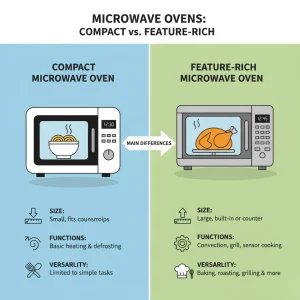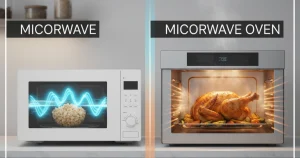Difference between microwave and microwave oven can be confusing—I realized this the hard way when I tried explaining features to a friend who thought they were identical. Many of us, including myself, often use the terms interchangeably without noticing subtle functional differences. In this article, I’ll simplify the choice, break down key features, and share practical tips for getting the most out of your appliance.

Pinpointed Topics Readers Will Learn:
-
The invention and history of microwave ovens.
-
Key components and how microwaves work.
-
Differences between a microwave and a microwave oven.
-
Benefits of inverter technology.
-
Cooking techniques and wattage guidance.
-
Safety tips and recommended accessories.
-
Choosing the right model for your needs.
Section 1: A Brief History of Microwave Ovens
-
Personal anecdote: first encounter with a microwave and being amazed by how quickly it cooks.
-
History of Percy Spencer and the accidental discovery of microwave cooking.
-
Introduction of commercial microwaves (Radarange) and later household models in the 1960s.
Enhancement Idea: Include a fun fact about melting a candy bar leading to modern cooking.
Section 2: What is a Microwave Oven?
-
Personal explanation of what makes your microwave your daily kitchen hero.
-
Definition: an electric appliance using electromagnetic waves to cook food quickly.
-
List of basic components with simple explanations:
-
Magnetron
-
Waveguide
-
Turntable/Stirrer
-
Control Panel
-
Cooking Chamber
-
Safety Interlocks
-

Enhancement Idea: Add a short humorous remark about how “my microwave knows me better than I know my own schedule.”
Section 3: How Does a Microwave Oven Work?
-
Explain in easy-to-follow steps with short sentences.
-
Generation of microwaves by the magnetron.
-
Interaction with water molecules in food.
-
Even cooking using turntable or stirrer fan.
-
Heat distribution from inside out.
-
Enhancement Idea: Include practical tip about why foods with high water content cook faster.
Section 4: Microwave vs Microwave Oven
-
Start with a personal observation: how often people use the terms interchangeably.
-
Explain that both refer to the same appliance, but:
-
Standard microwave: reheating, defrosting, quick meals.
-
Microwave oven: added features like convection, grilling, or baking.
-
-
Application differences: portion sizes, browning, and crisping capabilities.
Enhancement Idea: Use light humor: “Think of a microwave oven as a microwave with a little extra swagger.”
Section 5: Benefits of Inverter Microwaves
-
Explain inverter technology simply: provides consistent power, gentle heating.
-
Advantages:
-
Even cooking
-
Energy efficiency
-
Better for delicate foods like oatmeal or pasta
-
-
Personal tip: how inverter microwaves changed your own cooking routine.
Section 6: Understanding Microwave Wattage & Amperage
-
Explain wattage in plain terms: higher watts = faster cooking.
-
Explain amperage simply as electrical current drawn.
-
Provide common ranges (600–1,200 watts) and suggest 600–1,000 watts for most users.
Enhancement Idea: Include a relatable example: “I once tried a 600-watt microwave for a frozen pizza—it was fine, but the 1,000-watt model made dinner a breeze.”
Section 7: Cooking Techniques in a Microwave
-
Personal tips for everyday cooking:
-
Reheating leftovers (covering food for even heat)
-
Defrosting food (using partial power, flipping halfway)
-
Cooking eggs
-
Melting butter
-
Steaming vegetables
-
Enhancement Idea: Include one quirky personal anecdote about a cooking mishap that taught a lesson.
Section 8: Microwave Safety and Recommended Accessories
-
Discuss safe cookware: glass, ceramic, microwave-safe plastics.
-
Warning: avoid metals or decorative ceramics with metallic paint.
-
Introduce handy accessories:
-
Microwave plate covers
-
Crisper pans
-
Steamer trays
-
Pizza and bacon trays
-
Enhancement Idea: Light humor about avoiding sparks flying in your own kitchen.
Section 9: Microwave vs Convection Oven
-
Simple comparison table:
-
Microwave: fast heating, energy-efficient, best for quick meals.
-
Convection Oven: uses fan-circulated hot air, browns and crisps, better for baking.
-
-
Personal advice: choose based on cooking style and needs.
Section 10: Choosing the Right Microwave
-
Factors to consider:
-
Wattage
-
Size
-
Features (grill, convection, inverter)
-
Frequency of use
-
-
Personal recommendation: how you decided on your own model based on your daily routine.
FAQ – Difference Between Microwave and Microwave Oven
1. What is the main difference between a microwave and a microwave oven?
Honestly, there isn’t a huge difference—“microwave” is often just shorthand for “microwave oven.” Both appliances use microwave radiation to heat and cook food. Minor differences appear when features like grilling, convection, or inverter technology are added to a microwave oven.
2. Can I use a microwave and a microwave oven interchangeably?
Yes! In everyday use, they function the same. Just remember that some microwave ovens have extra cooking modes that a basic microwave might not offer.
3. Who invented the microwave oven?
Percy Spencer, an American engineer, invented the microwave oven in the 1940s. Fun fact: he discovered it by accident when a candy bar in his pocket melted near radar equipment!
4. Are microwave ovens safe to use?
Absolutely—when you follow safety guidelines. Use microwave-safe cookware, avoid metal, and always check labels on plastic containers.
5. What’s the difference between a microwave oven and a convection oven?
A microwave oven heats food using microwaves that excite water molecules. A convection oven, however, circulates hot air with a fan to cook food evenly, making it better for baking or browning.
6. Do inverter microwaves make a difference?
Yes! Inverter technology provides consistent power for even cooking, making it perfect for delicate foods like eggs, oatmeal, or reheating leftovers without overcooking.
7. How do I choose between a microwave and a microwave oven?
It depends on your needs. For quick heating and small portions, a basic microwave works fine. If you want grilling, browning, or larger-capacity cooking, a microwave oven with extra features is ideal.
Final Thoughts
The difference between microwave and microwave oven is subtle, yet understanding it can make your kitchen life a bit easier. From my experience, the choice really comes down to how you like to cook. If you mostly reheat leftovers or make quick meals, a standard microwave does the job perfectly. If you enjoy grilling, browning, or trying out more advanced recipes, a microwave oven with extra features might be worth the investment.
Personally, I like experimenting with different settings and discovering small hacks—like using a steamer tray for veggies or an egg cooker for breakfast sandwiches. Don’t be afraid to try out the features your appliance offers. You might just find a few new favorites that make cooking faster and more enjoyable.
At the end of the day, knowing the difference between microwave and microwave oven helps you choose wisely and use your appliance to its full potential. Happy cooking, and feel free to share any tips you’ve picked up along the way—I love learning new tricks too!